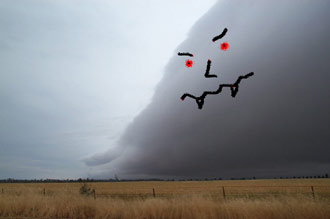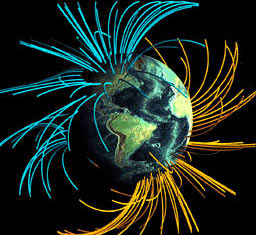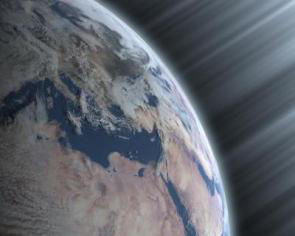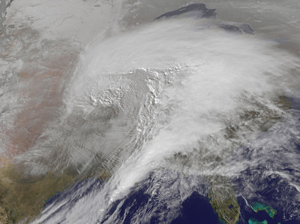[Note: I may have to start a series of “No, a blank won’t blank” posts; there’s been a spate of nonsensical doomsday pseudoscience lately. Sigh.]
 So the latest doomsday fearmongering I’m hearing about are global superstorms caused by dangerous shifts in the Earth’s magnetic field. Maybe you’ve heard: the Earth’s magnetic field is wandering around, and may be about to reverse. When this happens, incoming radiation will affect our weather, causing gigantic storms the likes of which have never been seen except in Hollywood movies.
So the latest doomsday fearmongering I’m hearing about are global superstorms caused by dangerous shifts in the Earth’s magnetic field. Maybe you’ve heard: the Earth’s magnetic field is wandering around, and may be about to reverse. When this happens, incoming radiation will affect our weather, causing gigantic storms the likes of which have never been seen except in Hollywood movies.
Panic! Death! Higher gas prices! Cats and dogs, living together!
Yeah, right. I’ll be up front right away: this claim is baloney. Garbage. Nonsense.
The article in question is pretty long, and as usual debunking something takes more time and effort than it does to simply say wrong things. So for the TL;DR (too long; didn’t read) crowd: the article makes basic science errors, attempts to link totally unrelated phenomena, states things as facts that are pure conjecture, and generally gets almost everything wrong. Bottom line: his claim of a link between the Earth’s magnetic field and superstorms is totally wrong.
OK, so you want details? I got details.
The source
As far as I can tell, the source for this silly claim is an article titled “Magnetic Polar Shifts Causing Massive Global Superstorms”, first seen online at helium.com, but also reprinted widely (I’m getting lots of emails from people who read it at the Oregon Salem-Online site). The author, Terrence Aym, wrote at least one breathlessly overblown and grossly inaccurate doomsday article without doing the necessary basic research; that one was about Apophis hitting the Earth in 2036 – and you know how I feel about that sort of thing.
This one is more of the same. Aym makes scientific claims that are completely unfounded in reality, and sometimes says things that are simply dead wrong.
For example, some of the basic science Aym claims is way off:
Worse, what shields the planet from cancer-causing radiation is the magnetic field. It acts as a shield deflecting harmful ultra-violet, X-rays and other life-threatening radiation from bathing the surface of the Earth. With the field weakening and cracks emerging, the death rate from cancer could skyrocket and mutations of DNA can become rampant.
 Bzzzzt! Nope. The Earth’s magnetic field protects us from charged particles like fast electrons and protons in the solar wind. If we didn’t have a magnetic field the Earth’s air would stop these particles anyway. The radiation he’s talking about – UV and X-rays – are totally unaffected by magnetic fields. That type of radiation is also absorbed by the air (including the ozone layer). Ironically, I will note that without the magnetic field protecting us, subatomic particles in the solar wind could erode the ozone layer, causing an increase in skin cancer rates from UV, but Aym doesn’t say anything about the ozone layer. And it takes X-rays to affect DNA [UPDATE: I’ve been made aware that some forms of UV light can affect DNA], which can’t get through our air no matter what. So that last statement of his is still wrong.
Bzzzzt! Nope. The Earth’s magnetic field protects us from charged particles like fast electrons and protons in the solar wind. If we didn’t have a magnetic field the Earth’s air would stop these particles anyway. The radiation he’s talking about – UV and X-rays – are totally unaffected by magnetic fields. That type of radiation is also absorbed by the air (including the ozone layer). Ironically, I will note that without the magnetic field protecting us, subatomic particles in the solar wind could erode the ozone layer, causing an increase in skin cancer rates from UV, but Aym doesn’t say anything about the ozone layer. And it takes X-rays to affect DNA [UPDATE: I’ve been made aware that some forms of UV light can affect DNA], which can’t get through our air no matter what. So that last statement of his is still wrong.
When something as basic as that is wrong in an article, it should make you at least a little suspicious about bigger claims. As well it should. But perhaps it’s an honest mistake. We all make ‘em, right?
But then he says this:
Magnetic polar shifts have occurred many times in Earth’s history. It’s happening again now to every planet in the solar system including Earth.
Um. No it’s not. Venus doesn’t even have a global magnetic field, for example, and there’s no indication I could find that any of the other planets have fields that are “shifting”. Aym doesn’t give a reference for that comment, so there’s no way to know where he got it from, or if he just made it up.
And here’s another bit:
Forget about global warming—man-made or natural—what drives planetary weather patterns is the climate and what drives the climate is the sun’s magnetosphere and its electromagnetic interaction with a planet’s own magnetic field.
This is another very confused passage. Of course global warming affects the climate: that’s why we’re so worried about it. His claim that the Sun’s magnetosphere drives the climate is also not true. What really drives the climate are several factors, including the Sun’s energy output (light and heat), how much the Earth absorbs that energy, the Earth’s rotation, its atmosphere content, the shape of its orbit, and so on. Most of these factors are stable (or don’t change much over time), which is why our Earth is so hospitable to life.
However, some factors do change, which is worrisome. For example, dumping so much carbon dioxide into the air is changing how much heat we absorb from the Sun, and that’s why so many scientists are concerned about global warming.
But what about magnetism?
Magnetic repulsion
The very basic premise of Aym’s claims is that the changing magnetic field of the Earth and Sun (he’s not clear which, actually, switching between the two in the article) can change our climate. There may be a modicum of truth in this idea; over long periods of time it’s possible the magnetic field may have some effect on climate. The evidence isn’t at all clear. However, Aym takes this and runs with it, linking short-term magnetic field changes with huge storms across the planet – essentially hyperinflating a real idea into nonsense.
 Here’s the deal: incoming galactic cosmic rays (GCRs; very zippy subatomic particles) hit the Earth’s atmosphere. They can seed clouds, changing rainfall patterns. They also create an isotope of oxygen at the same time which washes down in that rain. As it happens, cave formations called speleothems are sensitive to rainfall amounts, so by measuring the amount of the isotope in these formations, you can see if there is any correlation between that isotope and the amount of rainfall. Since the magnetic field of the Sun (and Earth) protects us from GCRs, then maybe changes in that magnetic field can affect rainfall.
Here’s the deal: incoming galactic cosmic rays (GCRs; very zippy subatomic particles) hit the Earth’s atmosphere. They can seed clouds, changing rainfall patterns. They also create an isotope of oxygen at the same time which washes down in that rain. As it happens, cave formations called speleothems are sensitive to rainfall amounts, so by measuring the amount of the isotope in these formations, you can see if there is any correlation between that isotope and the amount of rainfall. Since the magnetic field of the Sun (and Earth) protects us from GCRs, then maybe changes in that magnetic field can affect rainfall.
Scientists have looked into this, and what did they find?
… a relatively good correlation between the high-resolution speleothem δ18O; records and the dipole moment, suggesting that Earth’s magnetic field to some degree influenced low-latitude precipitation in the past.
That’s pretty interesting, I’ll admit. The correlation isn’t super-strong, but could be there. This idea of cosmic rays seeding clouds and affecting climate has been around for a while (I researched it pretty thoroughly for my book Death from the Skies!), and really, at best the data are interesting and suggest a possible correlation, but it’s impossible to say if there is any definite connection. It’s just too weak to be sure.
All well and good, and an excellent starting point for more research to try to nail this down… unless you read Aym’s article. Instead of quoting the actual paper, as I just did, he instead quotes from a website called ViewZone which is chock full of antiscience nonsense about astral projection, alien abductions, and 2012 doomsday:
“The earth’s climate has been significantly affected by the planet’s magnetic field, according to a Danish study published Monday that could challenge the notion that human emissions are responsible for global warming.AdvertisementAdvertisement“Our results show a strong correlation between the strength of the earth’s magnetic field and the amount of precipitation in the tropics,” one of the two Danish geophysicists behind the study, Mads Faurschou Knudsen of the geology department at Aarhus University in western Denmark, told the Videnskab journal.
Perhaps the author of the article did in fact say that; if he did then that’s not what the actual scientific study appears to say in the journal – there’s a big difference between a “relatively good” correlation and a “strong” one. But that statement is still confused and confusing. This has nothing to do with man-made global warming for one. It’s certainly possible and even likely climate change has several sources, but we know human emissions are a huge cause of it (despite what denialists claim). Even if cosmic rays were affecting us – and that’s not at all clear – then it would probably be minor compared to what we ourselves are doing. If it were that big a source of warming the data would be a lot more clear.
And even if this claim is totally true, it has nothing to do with superstorms, just with low-latitude rainfall. But Aym doesn’t stop there. In another quote he makes an unfounded claim piled on top of a distortion of a NASA finding:
Recently, as the [Earth’s] magnetic field fluctuates, NASA has discovered “cracks” in it. This is worrisome as it significantly affects the ionosphere, troposphere wind patterns, and atmospheric moisture. All three things have an effect on the weather.
These “cracks” are real, as described by NASA The thing is, though, they happen all the time and have been happening throughout history. They are not new, and are unrelated to magnetic fluctuations; the cause is actually described in the NASA article: sometimes the solar wind has an opposite magnetic polarity as the Earth’s magnetic field, allowing them to interact more strongly and form these cracks. So in that sentence Aym is misleading about the cracks and the Earth’s magnetic field, and then asserts flatly they affect weather, when no such connection is apparent.
Pole dancing
In the article, Aym claims the north magnetic pole of the Earth wanders, and this motion has sped up recently. He again ties this to the creation of superstorms. Yeah, well, not so much.
 The Earth’s magnetic field is roughly like that of a bar magnet, with two opposite poles. The field is generated in the Earth’s core as it spins, creating a dynamo, a self-sustaining reaction. The magnetic poles don’t line up with the Earth’s physical poles (its spin poles if you like), and they also wander. That’s because the field is generated by the liquid interior of the Earth, and so the field is not static. It changes. The poles can wander, too. As it happens, the north magnetic pole does appear to be moving faster than it used to; it averaged about 9 km/year of motion before 1970 and is now moving at about 40 km/yr (note that in the article, Aym says it’s 40 miles/year, but that may just be a typo on his part).
The Earth’s magnetic field is roughly like that of a bar magnet, with two opposite poles. The field is generated in the Earth’s core as it spins, creating a dynamo, a self-sustaining reaction. The magnetic poles don’t line up with the Earth’s physical poles (its spin poles if you like), and they also wander. That’s because the field is generated by the liquid interior of the Earth, and so the field is not static. It changes. The poles can wander, too. As it happens, the north magnetic pole does appear to be moving faster than it used to; it averaged about 9 km/year of motion before 1970 and is now moving at about 40 km/yr (note that in the article, Aym says it’s 40 miles/year, but that may just be a typo on his part).
Is that a concern? Not really. It moves a lot, and just because it’s speeding up now doesn’t mean doom and catastrophe (I imagine if it always moved quickly and suddenly slowed down, doomsayers would use that as evidence too). Note that the south magnetic pole hasn’t sped up, indicating this acceleration of the north pole is probably a temporary anomaly.
In any case, why would this motion be of concern? Beats me. Aym never really says why this is bad, or provides any evidence that it might be a problem. He just says it is.
Doomsday promoters also talk a lot about the poles flipping, literally with the two magnetic poles flipping orientation. This is a real event, and happens on geologic timescales. To be honest we don’t know what will happen when the poles reverse, but there is no evidence it will affect our weather. And anyway, it probably won’t happen for millennia in any case.
Weather or not
But what about all the severe weather we’ve had lately, including the ginormous storms that have swept across the United States, and the cyclone Yasi that just hit Australia?
 Well, those actually happen pretty often. It turns out cooler-than-average temperatures in the Pacific Ocean surface helped fuel and target the American snowstorms, while warmer waters near Australia fed the typhoon. That happens cyclically in the oceans – it’s the El Niño and La Niña cycle – and aren’t terribly surprising. The past couple of snowstorms have been pretty big, but there’s no reason whatsoever to link them to any magnetic issues. After all, the pole has been wandering for decades, so why would this happen now? And the Sun’s activity is still pretty low right now; so again there’s no reason to connect weather with the Sun. It’s hard enough to figure out how the Sun influences our climate over millennia, let alone season to season. Be very wary indeed of anyone claiming such an easy to spot connection (that’s also been missed by hundreds of scientists who have devoted their lives to such things).
Well, those actually happen pretty often. It turns out cooler-than-average temperatures in the Pacific Ocean surface helped fuel and target the American snowstorms, while warmer waters near Australia fed the typhoon. That happens cyclically in the oceans – it’s the El Niño and La Niña cycle – and aren’t terribly surprising. The past couple of snowstorms have been pretty big, but there’s no reason whatsoever to link them to any magnetic issues. After all, the pole has been wandering for decades, so why would this happen now? And the Sun’s activity is still pretty low right now; so again there’s no reason to connect weather with the Sun. It’s hard enough to figure out how the Sun influences our climate over millennia, let alone season to season. Be very wary indeed of anyone claiming such an easy to spot connection (that’s also been missed by hundreds of scientists who have devoted their lives to such things).
Ad naseum
The article goes on and on, piling up one distortion of science on top of another. And mind you, even if you slog through the entire article there’s one thing that becomes clear: Aym never makes a good connection between the magnetic field and superstorms! He says there’s one, but the best he can do is tenuously connect the magnetic field to climate in general and some weather like rainfall. But superstorms? Nothing.
Toward the end of the article he even links to a scientific article he claims makes a connection between the magnetic field and superstorms… but the article is actually talking about magnetic storms, not weather storms! Yeah. Oops.
Conclusion
So what’s the takeaway from all this?
Well, the big one is that breathless doomsday articles are generally hugely misleading, if not outright wrong. This one is certainly wrong. Big claims with shaky evidence, exaggerated conclusions, an apparent misunderstanding of basic science, and lots of supposition stated as fact – all this points to the conclusion that this article distorts reality beyond recognition.
Sadly, it’s not the first, nor will it be the last. I already have at least two more such articles on my radar and I know there will never be an end to them.
Until doomsday really does come, of course. But don’t expect those guys to get it right if and when it does.
Tip o’ the rain poncho to Michael Lonergan.
Image credits: Pittsburgh Supercomputing Center; Danish National Space Center; Arnaud Chulliat (Institut de Physique du Globe de Paris); NASA.
Related posts:
- Cosmic rays and global warming
- Snowpocalypse 2011 from space
- Repeat after me: Apophis is not a danger
- Betelgeuse and 2012
- Giant spaceships to attack December 2012?